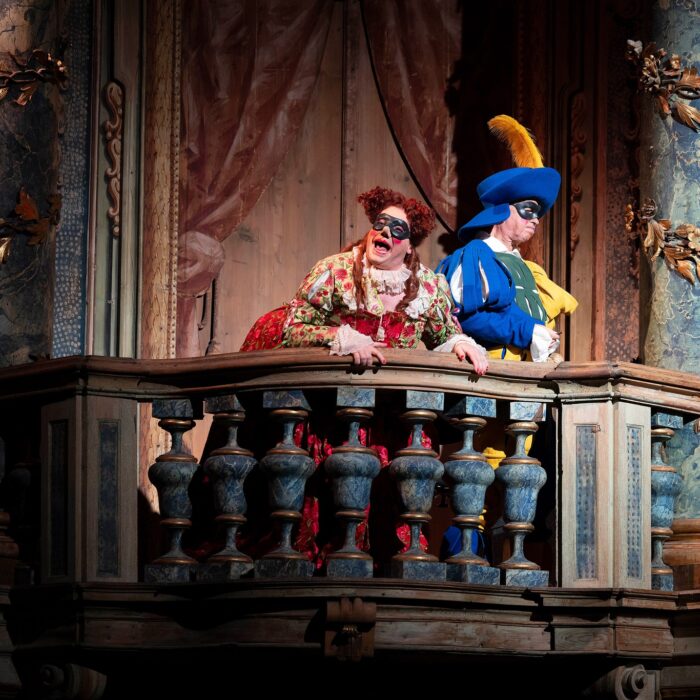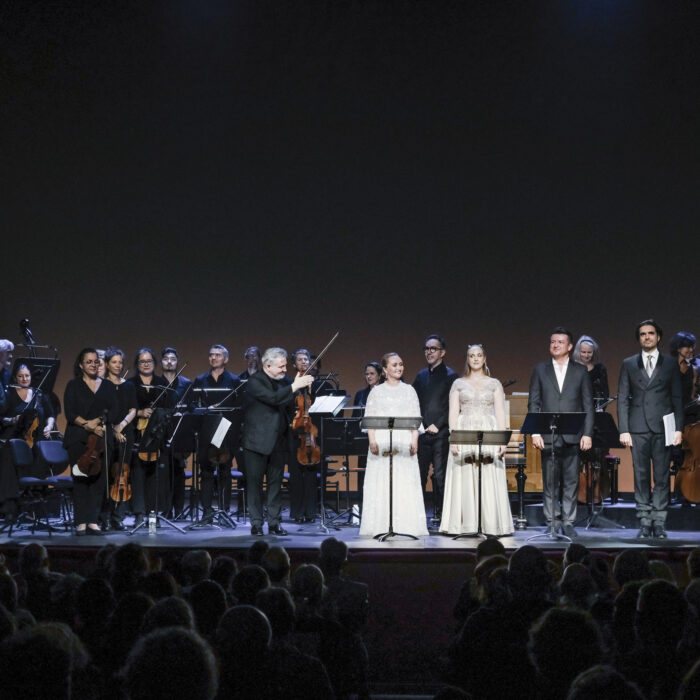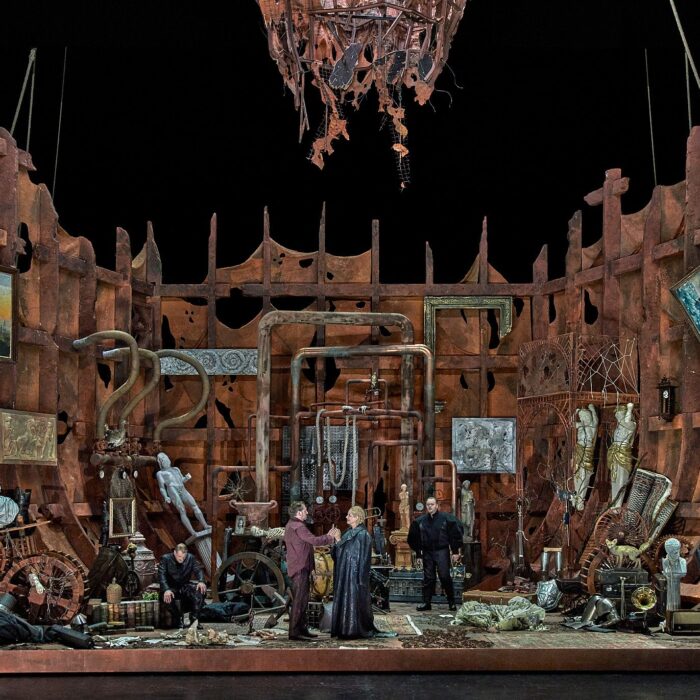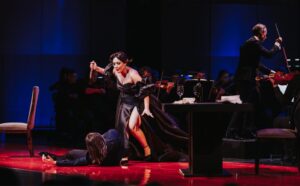
Canada’s National Arts Centre Orchestra 2025-26 Review: Tosca
Music Director & Conductor Alexander Shelley Illuminates Director Joel Ivany’s Perspective & Stellar Cast
By Jennifer Pyron(Photo: Curtis Perry, Canada’s National Arts Centre Orchestra)
Canada’s National Arts Centre Orchestra presented a semi-staged production of Puccini’s “Tosca,” in Salle Southam Hall, on Sept. 10, 2025 in celebration of this year’s season opening, marking the tenth season for Alexander Shelley as Music Director and Conductor. The evening was full of exciting musical moments by the orchestra and leading cast, including Ailyn Pérez as Floria Tosca, Matthew Cairns as Mario Cavaradossi, and Nathan Berg as Baron Scarpia. This stellar cast lineup also included Danlie Rae Acebuque as Cesare Angelotti/Jailer, George Theodoradopoulos as Sacristan, Jeremy Scinocca as Spoletta, Layne Spencer as Sciarrone, and the Ewashko Singers chorus.
Conductor Alexander Shelley and Director Joel Ivany developed this semi-stage version together alongside creative team members including Designer Michael Gianfrancesco, Lighting Designer Kimberly Purtell, Fight Director John Koensgen, Stage Manager Lesley Abarquez Bradley, Assistant Conductor Henry Kennedy, Chorus Master Laurence Ewashko, Assistant Director Vivien Ilion, Assistant Répétiteur Rebecca Klassen-Wiebe and Company Manager Kevin Waghorn. This was also produced in partnership with Edmonton Opera’s Emerging Artists Program and performed in Italian with English and French subtitles.
The musical quality of this production was superb as Shelley’s insight into Puccini’s score made the following review of performances impressionable.
Ailyn Pérez as Tosca
Soprano Ailyn Pérez was fantastic in the titular role. Her voice exceeded expectations and her acting skills fit perfectly into this semi-staged production. Her opening duets with Cavaradossi, ‘Mario Mario son qui!’ and ‘Ora stammi a sentir,’ highlighted her vocal agility and intuitive qualities as an intelligently aware singer. Pérez’s voice can fill any size hall at the drop of a hat, but what made this performance so special was the tenderness she showed towards her cast-mates. She took her time when performing with Matthew Cairns as Cavaradossi to lean into the emotional chemistry that must be developed all throughout this opera between the two. Pérez focused her vocal efforts in this way and portrayed Tosca as playful and compassionate, willing to the lead for the benefit of those she loved. Her rambunctiousness was refined and it was her voice that rose above her character for the entire performance.
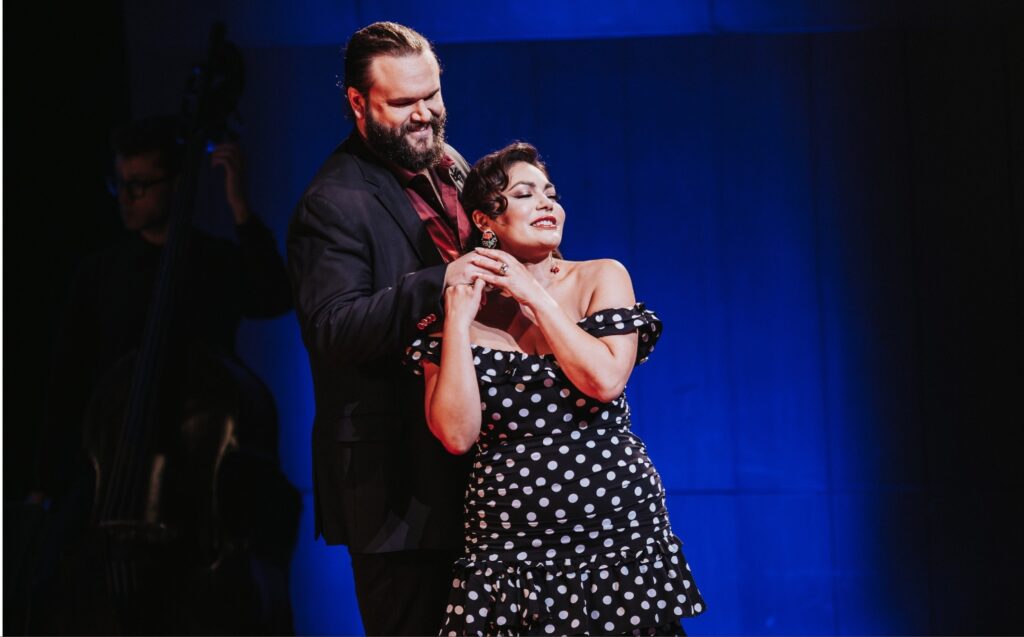
(Photo: Curtis Perry, Canada’s National Arts Centre Orchestra)
Like her 2023 performance of “Florencia en el Amazonas,” which showed fiery excitement behind every note, her Tosca had that same fire. As Tosca continued to “fight” for her lover’s gaze in the opening act of this particular performance, her phrases “Non la sospiri la nostra casetta” captivated the audience and all eyes and ears stayed on her for the remainder of the night. Pérez’s high notes soared into Southam Hall with ease and fluidity. There was a fresh and silvery tone that glittered in its delivery due to her supported vocal technique and grounded middle range. Her facial expressions made her vowels perfectly open and warm, while also contributing to her character’s emotional evolution. Her costumes were also beautiful in this staging; the first dress had polka dots with flattering ruffles, the second dress was in a severely dramatic black with puffed sleeves and a high-cut slit up her left leg (making it easy for Scarpia to be lured into “Tosca’s kiss”). Her final dress was a modern white that had one long-sleeve and was made out of material similar to latex. All three dresses really set the tone for all of Tosca’s moods and the audience loved it!
Her duet with Baron Scarpia, “Orsu Tosca parlate,” really was a turning point in the seriousness of this semi-staged production. Pérez’s voice emoted a new level of desperation in her pleading to stop the torture of Mario by Scarpia’s men. Her acting skills were superb and Nathan Berg as Scarpia responded to her at the same high standard. During one of the most famous arias of the opera, “Vittoria Vittoria!,” Pérez revealed Tosca’s undying commitment towards Mario at all costs, however this felt like only an appetizer for her iconic and legendary aria, “Vissi d’arte.” In this aria, her voice went into another realm of imagination and otherworldly design. Pérez’s razor sharp focus on managing her tight-spun vibrato made each note sound more brilliant than the last. Her interpretation of “Vissi” was rooted in classical tradition balanced with the richness of her full-bodied timbre. It felt brand new coming from her and this made all the difference for “Tosca,” yet again proving how true masterpieces never fade.
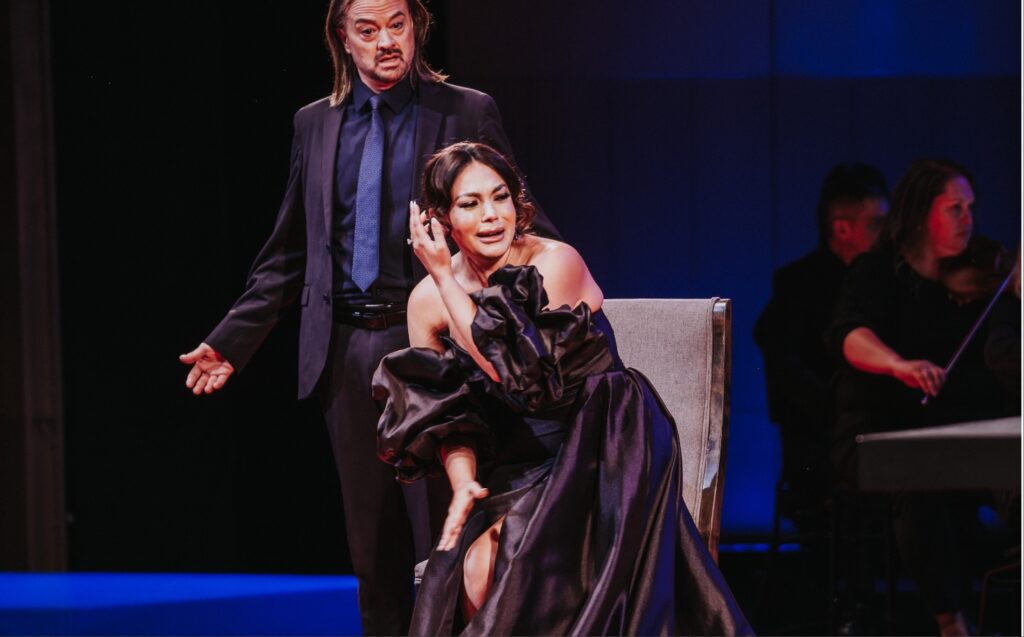
(Photo: Curtis Perry, Canada’s National Arts Centre Orchestra)
“Tosca finalmente mia” was one of Pérez’s grandest gestures to silence the evil Scarpia, especially as she watched him choke on his own blood after stabbing him with his own knife. Her voice was riveting! Her black dress draped over his cold body and she waited until he slipped into death’s embrace before then realizing herself as a murderer. Her evolution in this one scene alone was astounding in its depth and dimensionality. Berg as Scarpia also kept up with where she was going and took on his role as a mirror to her force. I will never forget watching her face turn into shocking bewilderment at her own doing–amazed by her own power in the finality of one’s own mortality at the same time. It was a revelation!
This was all leading up to her greatest display of all, her final aria, “Come e lunga l’attesa.” Pérez comforted her Mario while longing for a better life and hoping for a bright future ahead without Scarpia in their way of happiness. She didn’t waste a thought on Scarpia until realizing the guns poised to fire at Mario were in fact loaded. Despite her effort and sacrifice to save him, Pérez as Tosca turned into a woman with nothing to lose and everything to gain by justifying her own actions all the way up to her final leap of faith and into the arms of death. Her performance still resonates with me today and I want to see her do this role in a fully staged production.
Stellar Support
Tenor Matthew Cairns as Mario Cavaradossi came across as gentle and kind in his role. His voice resonated with clarity and lightness. His opening aria, “Recondita armonia,” was pure and delightful. He interacted with Tosca and Angelotti very naturally. His opening duet with Pérez (Tosca), “Mario Mario son qui!,” was entertaining. His voice blended easily with her whims of torment for his attention after discovering his most recent painting to be of Angelotti’s sister, the Marchesa Attavanti.
Cairns’ evolved his acting skills almost before the audience’s eyes, especially after his torture scene. His voice during, “Vittoria, Vittoria!,” resonated full bodied into the hall and the orchestral swells empowered him to hasten his tempo a bit. His interpretation of “E lucevan le stelle” was beautiful and captivating.
Bass-baritone Nathan Berg as Baron Scarpia was superb. His voice during “Un tal baccano in chiesa” was commanding and booming with aggression. The orchestra matched his tone and made this a memorable intro before the captivating “Te Deum” chorus. The entire time while observing Berg, I made note of how I want to review his performances in Wagner’s Ring Cycle. His overall demeanor and presence is made for Wagnerian repertoire. Alas, Berg’s Scarpia really hit the high notes of this evening’s performance and made this semi-staged production feel full of life and vengefulness, weighted by the desires of a greedy man acting with impunity. This was history repeating itself in operatic form, which is also what makes “Tosca” timeless and absolutely relevant today.
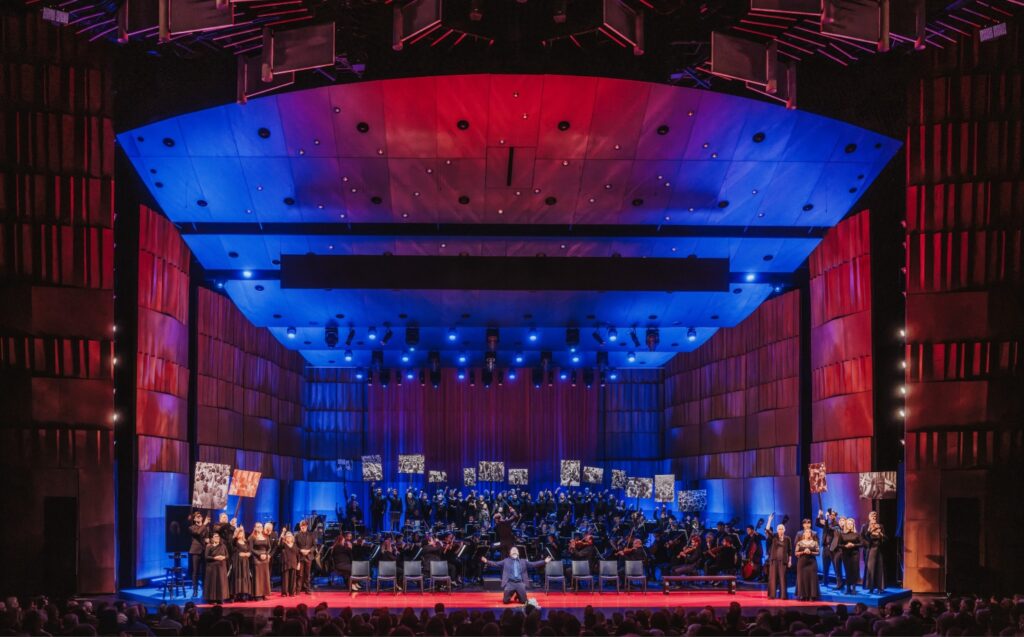
(Photo: Curtis Perry, Canada’s National Arts Centre Orchestra)
Berg’s “Te Deum” was haunting. The chorus and orchestra really amplified his ethereal delivery as he went into the spiral of his own demise, relishing over his eventual “triumph” because he “always gets what he wants.” His hero’s journey is marked by the very depths of his darkest imagination, tormenting him with torture that eventually plays out as the torture shown to Cavaradossi and Tosca. Berg’s interpretation of these complexities was fascinating to feel from the audience’s perspective. He tilted his head back in all his “glory,” allowing the voice’s of the Ewashko Singers chorus to wash over him in justification and praise. The ultimate “winner” of the fascist prize made real in this moment.

(Photo: Curtis Perry, Canada’s National Arts Centre Orchestra)
His duet with Tosca, “Io tenni la promessa,” during negotiations of her and Mario’s forever escape from his grip is one of my all time favorite orchestral moments in an opera. The strings hit the highest highs and lowest lows, tormented by life’s grim reality, only for a moment before raising in elation during the struggle between the two. Tosca’s kiss is Scarpia’s sweetest surprise and the orchestra ascended as Scarpia grappled with his own mortality. His final gasping on his own blood mixed with the swirling strings in the background. Alex Shelley’s musical direction in this moment brought tears to my eyes and illuminated the finest details of Puccini’s score and the excellent mastery of the musicians of the orchestra.
Danlie Rae Acebuque as Cesare Angelotti/Jailer, George Theodoradopoulos as Sacristan, Jeremy Scinocca as Spoletta, Layne Spencer as Sciarrone also gave outstanding performances on this night.
Production Details
Director Joel Ivany’s perspective of a semi-staged “Tosca” worked well in Southam Hall’s space and with its natural resonance. He managed to fit the entire orchestra on stage along with cast members moving around the musicians all throughout the opera. The specific moments that stood out the most happened during the “Te Deum” as all of the chorus members took to the stage and surrounded Scarpia with picket signs that showed moments in history depicting protest and uprising in resistance. The various and ambiguous photographs left a lot to one’s own imagination about where the protests took place and why. “Tosca,” as previously stated, is timeless and so Ivany’s choice to have this moment left open to one’s own interpretation felt natural.
The other moment that made a strong impression was the most obvious one–Tosca’s leap of death. Since their was no actual set design constructed for her to leap from, Ivany had Tosca stand on top of the risers behind the orchestra and hold up a white sheet like angel wings in surrender. She then raised her arms and dramatically dropped them as the visual projections depicted a massive red curtain falling while her body collapsed onto the risers (partially hidden by the orchestra). This came across as best as possible in this semi-staging scenario. The more I let this ending sit with me, the more I realize that while Tosca is “expected to commit suicide,” like most sopranos in opera, this interpretation of her death felt liberating instead of damning. The realization Tosca has before her death is that she will meet Scarpia (and obviously Mario) on the otherside. And so, this production’s ending felt like she forgave herself before she leapt and therefore was already free before her own death. This left a lasting impression and I remember listening to audience conversations around this particular choice of ending, so already people were interpreting in their own way, continuing the conversation about Puccini’s masterpiece. This is the power of “Tosca” and how opera as an art form continues to survive. No matter the point of history in which it is shown, opera is political and one’s own mortality is finite.
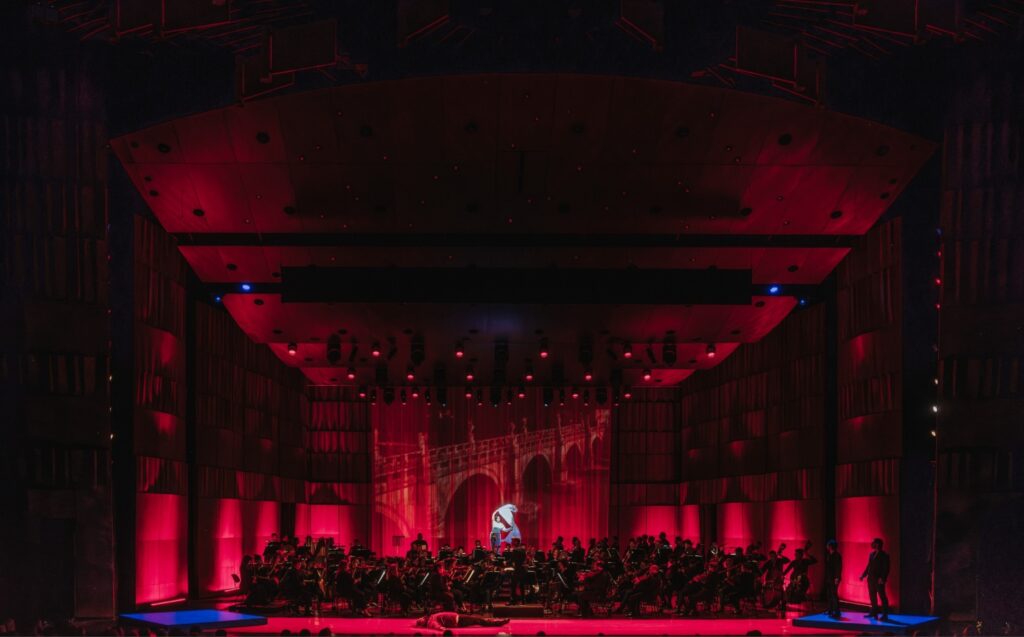
(Photo: Curtis Perry, Canada’s National Arts Centre Orchestra)

